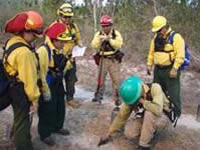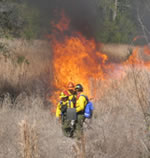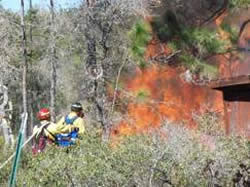
National Fire Plan Success Story
U.S. Fire Manager Helps Train International Firefighters
Interagency Prescribed Fire Training Center, Tallahassee, Florida
National Fire Plan - Firefighting, Fuels Reduction
2008

Danny Cedeno, engine module leader, going over some of the tactics that were used in training.
In February, a group of six firefighters from Guatemala, Honduras, and Mexico took part in the first ever Spanish-language prescribed fire training module provided at the national Interagency Prescribed Fire Training Center. Led by Joe Flores, U.S. Fish and Wildlife Service Assistant Fire Management Officer stationed at Browns Park National Wildlife Refuge, the international group spent three weeks learning about prescribed fire and conducting burns.
The U.S. Fish and Wildlife Service, using prescribed fire on refuges since the 1930s, has been a leader in operating the training center. Firefighters from across the United States come to this facility, established in 1998 in Tallahassee, Florida.

Members of the crew burning grass.
The international group spent 10 days of the three-week session working with the Florida Division of Forestry in Tate’s Hell State Forest, where they completed 11 prescribed burns covering a total of 3,000 acres. The largest burn was 1,900 acres and the smallest was three acres in an area near homes. Flores said the burns were primarily to reduce hazardous fuels that included conifer, palmetto, grasses and shrubs.
Flores, who speaks Spanish, said that the group included three participants from Mexico, one from Guatemala and two from Honduras. Among them were employees of The Nature Conservancy, a professor, a state Fire Management Officer, and a regional fire coordinator, ranging from 27 to 50 years of age. Flores was assisted by Danny Cedeno, Engine Module Leader, Apalachicola National Forest, Florida.
"Most of the trainees have been fighting fires for a long time, but they are just starting to learn about prescribed fire" said Flores. "I have never seen people so interested in what we do. They took pictures, wrote down information and asked questions about everything. They really wanted to learn how to burn and start doing the work back in their countries."

A Wildland Urban Interface prescribed burn in a subdivision. The building is an old outhouse.
Flores noted that in Mexico it is still against policy to allow prescribed burns, but they hope to change that within the next few months. "I would say that they are where ost of the United States was 30 years ago — all fire suppression but no prescribed burning," he said, adding that Guatemala and Honduras both have limited prescribed burn programs. "They know that there is a lot of work to do before they can get their programs up and running," he said.
At the conclusion of the training, each of the crewmembers wrote down a list of 10 things they will take home from the training. The lessons learned include:
- "Safety in prescribed burns is and should be the highest priority"
- "The ignition plan is one of the most flexible parts of the burn. It should be adjusted due to weather conditions present on the burn. The burn environment is an ever changing environment. The evaluation of the situation should be constant and the burn boss will make corresponding decisions to adjust the plan."
- "Smoke management is a fundamental part of the burn process and so is mitigating the effects to the population."
- "Communication is one of the most important tools for the burn boss and the crews. It should be clear and constant to all levels of the organization."
- "In the beginning (of a prescribed burn program) it is important to learn from mistakes and make and achieve changes. Leadership plays a very important role in conducting prescribed burns."
- "The relationship between the size of the burn and complexity of the unit is not a direct relationship. When there are houses near the burn unit or it is a small unit you need to put spot fires out quicker in small units or in the WUI."
The Prescribed Fire Training Center plans to hold an international training session each year. They have invited Flores back to help train in 2009. In addition, Flores has been invited to Mexico to speak at an upcoming conference on prescribed burns.